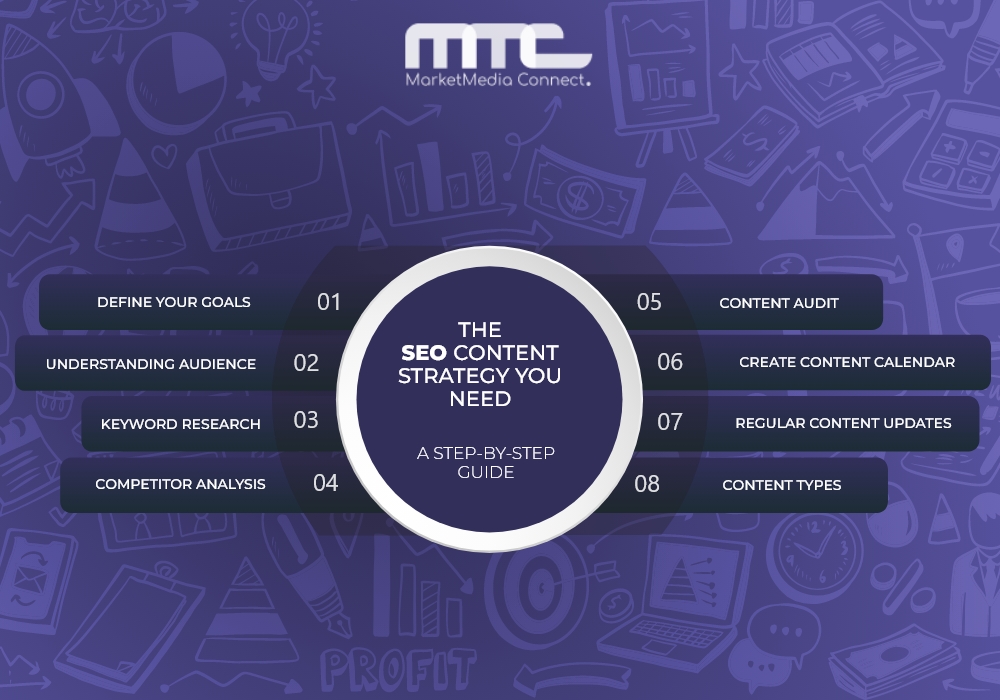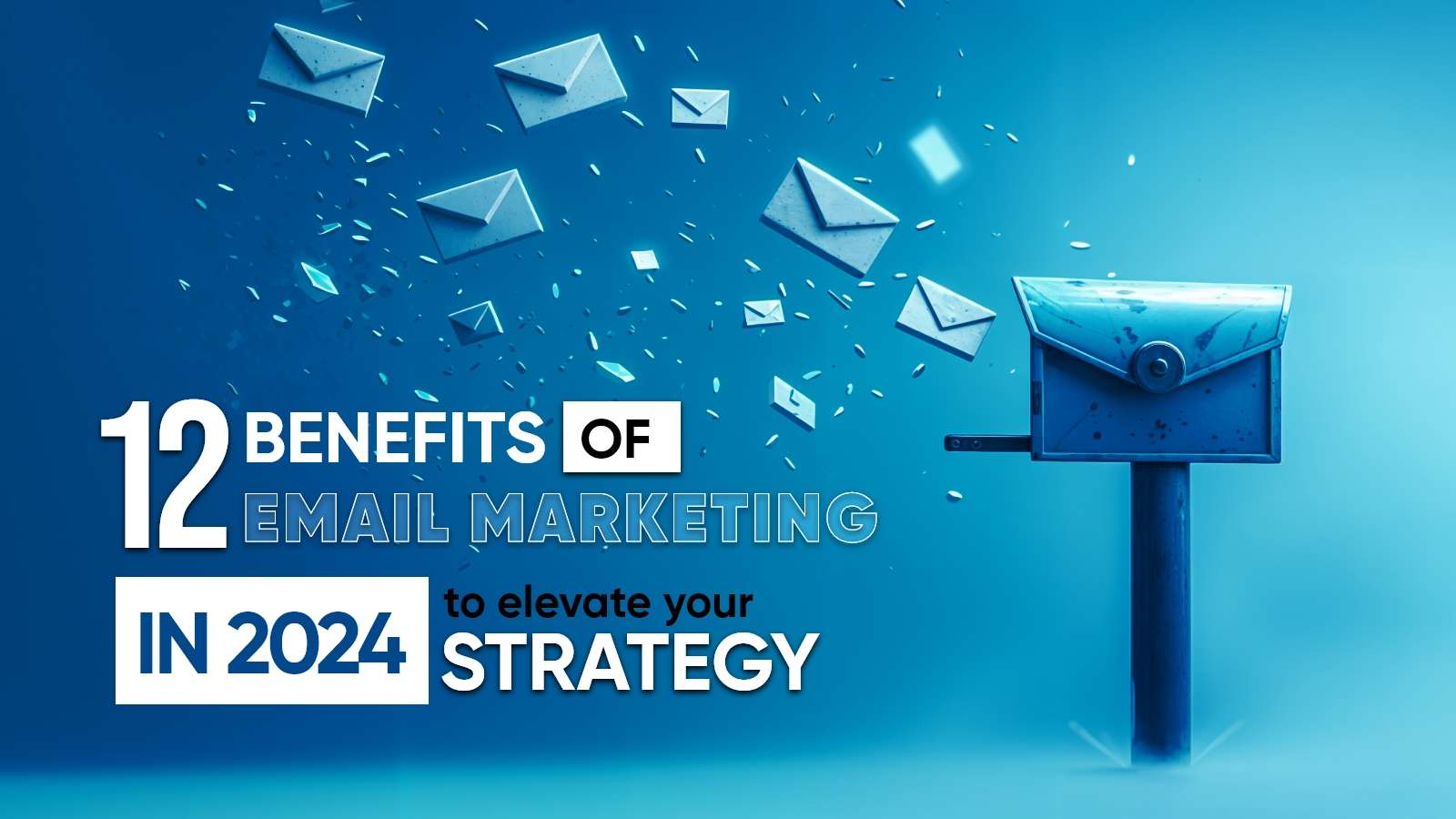Content
The SEO Content Strategy You Need: A Step-by-Step Guide
An effective SEO content strategy is key for any online presence in today’s constantly shifting digital market. Attracting traffic alone won’t do; targeting and engaging the appropriate audience are essential to making a lasting impression and winning loyal followers or customers. This detailed guide will guide you through creating an SEO content strategy designed to satisfy search engines and connect with readers so that your content not only ranks well but resonates well, too!
Steps to make your SEO Content Strategy:
Here are 8 simple steps to make an effective SEO content strategy for your business:

Define Your Goals
Setting clear goals before initiating an SEO branding strategy is essential to success. Deliberate in defining them precisely, whether increasing website traffic, generating leads, or increasing sales. Each goal may necessitate a unique approach when planning content strategy for SEO purposes.
For instance, if your goal is to drive more website traffic, your content strategy might focus on producing informative blog posts and guides that address common queries in your industry. Conversely, if lead generation is your main priority, consider including gated content, such as downloadable resources that capture visitor info.
Understanding your goals provides direction and allows you to measure success accurately. Set specific, measurable, attainable, relevant, and time-bound (SMART) goals to guide content production efforts effectively.
Understanding Your Audience
An integral component of SEO content strategy is understanding the target audience. Conduct thorough research to develop detailed buyer personas. Understand their pain points, preferences, and platforms they visit frequently – social media listening or surveys may offer invaluable insight.
Understanding your audience makes it possible to conduct a content quality checker that ensures the content meets their needs. For instance, if your target demographic prefers visual content such as infographics and videos, adding more of these items might help engage them more deeply with what’s on offer. Also, consider your target market’s language, tone, and style preferences to provide viewers with an engaging and relatable experience.
Constantly review and update your buyer personas as your audience evolves to ensure your content remains relevant and meets their needs.
Keyword Research
Keywords serve as the cornerstones of user navigation to your content. Conduct thorough keyword research to understand your audience’s phrases when searching for information online. Use tools like Google Keyword Planner, SEMrush, or Ahrefs to find high-traffic words within your industry.
Though short-tail keywords are essential, don’t underestimate the power of long-tail ones. Long-tail keywords often reflect user intent more precisely, increasing your chance of attracting those seeking exactly what you’re offering.
Once you’ve identified your target keywords, use them strategically within your SEO content strategy. Ensure the integration is natural; keyword stuffing could negatively impact search rankings. Create content that addresses audience questions about these words while offering insightful and informative answers.
Keyword research should be an ongoing process. Regularly revisit and revise your keyword strategy to stay ahead of shifting search trends and changing user behaviors.
Competitor Analysis
Gain a clear picture of who your competitors are and evaluate their content strengths and weaknesses using tools like BuzzSumo. BuzzSumo also allows for quick identification of popular posts shared among audiences, providing insights into what resonates best with the target demographic.
Examine the type of content creation, distribution platforms they utilize, and engagement metrics they receive – not only will this provide a deeper understanding of their competitive landscape, but it may also expose opportunities for differentiation.
Discover content gaps left unfilled by competitors; these allow you to add unique value for your audience. Additionally, identify where competitors are most active so that you can strategically position your content for maximum exposure.
Discover your competitors’ strengths and shortcomings to create an unparalleled online experience for your brand. By adapting and improving upon their strategies, you can find ways to distinguish yourself in an increasingly crowded online landscape.
Content Audit
Confirm that any outdated information is correct by updating statistics, facts, and references. Examine the engagement metrics of each piece – what articles have the highest number of shares, comments, or backlinks? Leverage these insights as guidance for your future content creation efforts.
Repurposing content can be a powerful strategy when conducting a content audit. Look out for pieces that could be transformed into different formats – perhaps blog posts could become podcast episodes or social media graphics to maximize the value of the existing library. This approach maximizes its value.
Conducting a content audit allows you to ensure that your SEO content strategy builds upon a solid base, drawing upon its strongest assets while addressing areas that require improvement.
Create a Content Calendar
The organization is key to maintaining consistency in your SEO content strategy and creating a content calendar as your roadmap by outlining the topics, formats, and distribution schedule for all your posts.
Start by aligning your content calendar with both business goals and industry events. Seasonal trends, holidays, and industry conferences all impact how and when we publish. Making this connection will ensure your content remains timely and relevant for audiences.
Rethink your content calendar strategy. Instead of publishing long-form pieces each week, vary them with shorter pieces that cater to different learning preferences and keep audiences engaged. This approach helps keep audiences engaged while catering to other learning preferences.
Plan effectively by allocating resources efficiently. Set key milestones such as content creation, editing, and promotion to facilitate an uninterrupted workflow. A content calendar increases efficiency and allows you to maintain an effective presence within your audience’s digital landscape if you lack resources – affordable SEO Content creation services offer similar services that will create it for you.
Regular Content Updates
Search engines favor relevant and current content. You can keep older posts relevant by reviewing and revising them periodically to maintain relevancy and ensure your search engine rankings stay relevant.
Keep abreast of industry trends and periodically add fresh topics to your SEO content strategy, which keeps it engaging for returning visitors. This ensures a successful user experience.
Content Types
Diversifying your content types is like providing a varied menu tailored to various tastes. Your audience consumes information in different ways; including multiple forms of media will broaden reach and engagement.
Start with blog posts as the foundation of your SEO content strategy. Write articles that address questions and concerns your target audience raises; long-form pieces provide excellent opportunities for in-depth exploration of subjects.
Visual content can be an excellent way to present complex data in an easily consumable manner. Create visually appealing graphics highlighting key points or statistics from longer articles; these assets can easily be shared on social media.
Discover the immense potential of video content. Whether tutorials, interviews, or behind-the-scenes peeks – video provides a powerful way to reach your audience. Platforms such as YouTube and social media channels offer ideal venues for video distribution.
Interactive content such as quizzes, surveys, and infographics encourage audience engagement by inviting participation. Not only can this improve user experience, but it can also provide invaluable data that can inform future content-creation efforts.
Remember when selecting content types to use with your audience: the key lies in aligning their preferences with what works for you and regularly assessing each one’s effectiveness to adjust your strategy based on what resonates most strongly with them.
Conclusion
An effective SEO content strategy involves the following:
- Understanding your audience.
- Developing content that adds value.
- Continuously optimizing based on performance metrics.
It’s a dynamic process requiring patience, consistency, and adaptability – by following these steps, not only will your search engine rankings improve, but you will also build meaningful relationships with audience members that result in increased traffic and engagement on your site – keep in mind SEO is not a sprint but rather requires long-term dedication for lasting success.









